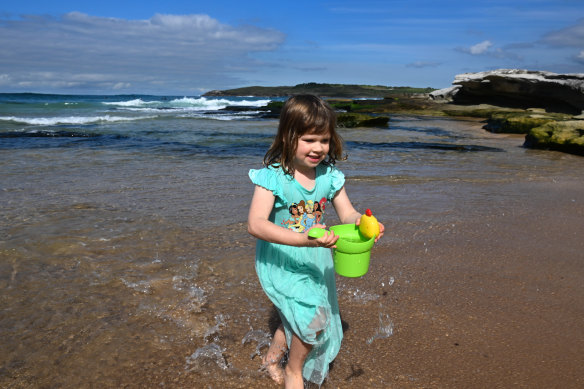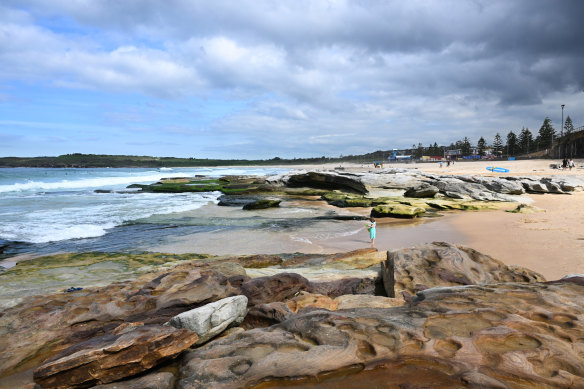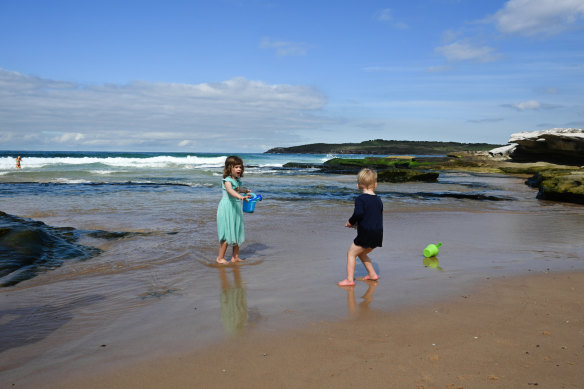This was published 8 months ago
The ‘hidden treasure’ buried under the sand at popular eastern suburbs beach
Winter storms have uncovered a beautiful yet ephemeral rocky cove at the northern end of Maroubra beach.
Several days of strong swells earlier this month washed away sand, revealing a shallow inlet surrounded by green-tinged sandstone that is delighting beachgoers.

Five-year-old Alice plays in the new cove that has appeared at North Maroubra.Credit: Janie Barrett
Blake Thornton, a lifeguard with Randwick City Council, said sand erosion occurred in the area most years, but it was more dramatic this year because the swell was unusually prolonged.
He said the fact the rocky cove was different every year made it feel fresh and almost magical.
“You can let your imagination run wild – what else is lying under the sand?” Thornton said.
“It takes something like this to make you realise how powerful the ocean is and how quickly things can change – we had such a large build-up of sand, and then three days later, something completely new is exposed, like a hidden treasure.”
Thornton warned that the rocky cove was fine to visit but not a good place to swim because of a permanent rip at the north end of the beach.
Randwick Council expects the geographic feature to be there for a few months until the sand builds up again.
This natural process of beach erosion and replenishment could be disrupted by climate change because of sea level rises and an increase in coastal storms.
NSW climate modelling released on Tuesday warns that sea levels for Sydney could rise by 18 centimetres by 2050 and 35 centimetres by 2090 under a low-emissions scenario aligned to the Paris Agreement. Under a high-emissions scenario, they could rise 22 centimetres by 2050 and 56 centimetres by 2090.
University of Melbourne research suggests that climate change is making waves and storm-driven swells bigger. In the Southern Ocean, the average wave has grown about 20cm in the past 30 years.

Large swells washed the sand away, exposing a rocky cove at North Maroubra.Credit: Janie Barrett
Professor Andrew Short from the University of Sydney’s School of Geosciences said sea level rises generate slow erosion everywhere, while coastal storms generate sudden temporary erosion, and both can occur at once.
Beaches such as South Maroubra that back onto dunes recover faster than those with a sea wall, such as North Maroubra.
“Sea walls and rock shore hinder recovery because sand is deposited on the beach when the waves run up in calmer conditions - they soak into the sand and leave the sand behind [that] they’re transporting,” Short said.
“When you have a rock wall or rocks, the waves can’t soak into the beach because they hit a cement or rock wall, and they’re reflected back out to sea.”
Further north, between Bondi and Tamarama, the mysterious Mackenzies Bay forms a sandy beach amid rocky outcrops only every few years after prolonged gentle conditions.
Short said the coastal storm earlier this month delivered waves about eight metres high for three or four days, eroding all NSW beaches to some extent. He said Collaroy on the northern beaches was among the worst hit, especially under the sea wall.

Alice and her brother Neo, 2, playing in North Maroubra’s new rocky cove.Credit: Janie Barrett
A European research paper published in Nature Climate Change in 2020 predicted that half the world’s beaches would disappear by 2100 because of rising sea levels, including 40 per cent of Australia’s 12,000 beaches.
Short was a co-author on a response that pointed out that was only true for beaches backed by houses or a seawall, while those backed by natural dunes or sand plains could retreat inland.
“At beaches like Bondi and Manly and Collaroy and Bilgola, you’ll end up with a sea wall and no beach unless they are nourished by more sand being pumped onto the beach to replace the eroded sand.”
Short said in places such as the Gold Coast it was already common for councils to replenish the beaches with sand brought from further out to sea, but this was yet to occur at any large scale in Sydney.
Get to the heart of what’s happening with climate change and the environment. Sign up for our fortnightly Environment newsletter.